Herbs and spices play an integral part in learning how to cook. Developing a spice collection takes both time and money. Spices tend to be somewhat expensive and some spices are a lot more expensive than others. Below is a very basic beginner spice list that will be be a good start to your spice collection.
The spice section of the grocery store is the ONLY section of the grocery store that is alphabetized. It’s a good thing they are in some sort of order, because there are hundreds to choose from.
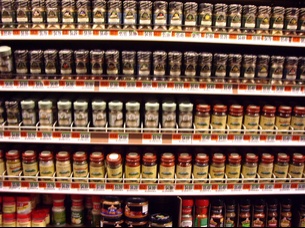
Spices at the Grocery Store
If you do not have any dried spices in your cupboard, there are six basic spices you need to begin with:
- salt (is actually a mineral and not a spice)
- pepper
- oregano
- garlic powder
- onion powder and
- cinnamon
Eventually you will be buying a lot more spices depending in your own personal tastes. (Some of the more popular spices used today are allspice, cardamom, cloves, ginger, mace, nutmeg, paprika, saffron and turmeric. Also, Spice blends, like curry powder, chili powder, garam masala, pickling spice, cajun seasoning (Bam!), and pumpkin pie spice).
For now, start with these six listed below.
1. Salt
The course of history has been altered by salt. Wars have been fought over it, and many books have been written about it. Once considered an extremely expensive commodity, it is now probably the least expensive spice you can buy.
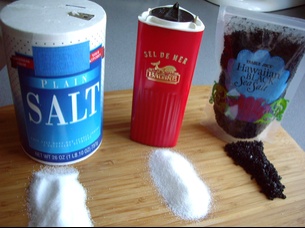
Plain Salt, Sel de Mer, Black Hawaiian Sea Salt
The grocery stores sell a few different forms of salt. Gourmet specialty shops sell really exotic salts. Buy a box of “Plain Salt”. It usually comes in a cylinder shaped box.
You will use salt in just about everything you choose to make, both sweet and savory.
2. Pepper
White or black pepper is sold either pre-ground or as pepper corns which need grinding. Peppercorns also come in red, pink, and mixed.
Freshly ground pepper corn is great, but it does require investing in a pepper mill. At my local kitchen shop, grinders range in price from $20 to $100. That can be a steep investment for someone just starting out! My advice is…if you can afford it…go for it!
The grocery store does sell inexpensive, non-refillable grinders, but they produce a very course uneven grind of pepper.
If you do not have a pepper mill and do not want to invest in one, buy ground black pepper.
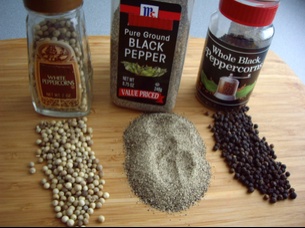
White Peppercorns, Ground, and Black Peppercorns
Do keep in mind that fresh ground pepper has a much stronger taste then pre- ground pepper.
3. Oregano
We often associate the herb oregano with Italian foods, but it is also found in Mediterranean and Mexican foods.
You can buy oregano dried or fresh in the produce section of the grocery store.
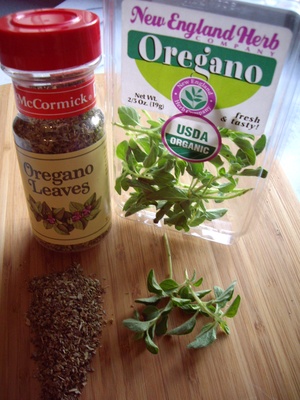
Dried and Fresh Oregano
If you are using fresh herbs instead of dried the ratio is 3 to 1. So if the recipe calls for 1 teaspoon of dried oregano, you would use 3 teaspoons of fresh oregano.
When using dried oregano, crush it between your finger tips as you add it to the recipe. This will help release the aroma and flavor.
Adding a pinch (literally what you can pinch in two fingers) to a jar of store-bought spaghetti sauce makes all the difference in the world to the flavor of the sauce.
Sprinkling a bit onto pizza will give it an extra ‘zing,’ and it’s great on garlic bread.
4. and 5. Garlic Powder and Onion Powder
Garlic and onion are two flavors that occur over and over again in all cooking. Granted, the fresh form is wonderful but the dried powder works brilliantly on things like roasted potatoes and sprinkling on grilled meats and fish. That said, my first preference is to always use the real McCoy!
I have written extensively as well as made videos on fresh onions and garlic. The only way a beginner cook can develop confidence working with onions and garlic is…practice, practice, practice! In due time those skills will develop but until then, a recipe for roasted potatoes (for example) may be far less intimidating to try if the only skill required is for you to wash and cut the potato and measure in some spices.
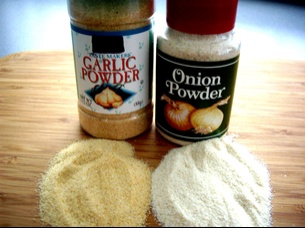
Garlic and Onion Powder
At the grocery store, be sure to get the garlic powder and onion powder, not the garlic salt, or onion salt. It’s better to add your salt separately.
6. Cinnamon
Nearly everybody likes cinnamon! Mix it with a bit of sugar and have it on your toast in the morning. Sprinkle it on your coffee or hot chocolate, or add it to oatmeal. Once you actually start cooking you will be amazed at how many savory dishes it can be added to. It adds a lot of interest to stews and curries, as well as ground beef.
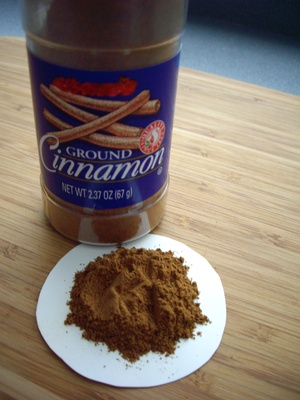
For now, that’s it. It only takes six different spices to spice up your life!
I would love to hear what my readers, who are experienced cooks, think the next six should be for a beginning chef!
If you are new to startcooking, or are a regular visitor here, please consider subscribing for free.








































DBK said:
Not to be a contrarian, but I think a pepper mill is an important part of a ktichen, and since they now sell peppercorns with a pepper mill built into the container, it is easy and (in the short run) inexpensive to buy a pepper mill. The oils in peppercorns are very volatile and break down quickly once the spice has been ground. When you buy ground black pepper, you are guaranteed to get a spice that isn’t worth the money you paid. If people are to really enjoy cooking and appreciate what they cook, they should use freshly ground black pepper. I know the point of this blog is to get beginers to appreciate how easy it can be to cook, but buying the peppercorns in the container with the built-in spice mill is easy enough, I would say.
For the next six, I say basil, thyme, cayenne (because if you like a little heat, it can really be a versatile spice), ginger (now you can cook Chinese!), and that’s about it. I personally like to use fresh herbs mostly and add them at the end of the cooking process so they become incorporated but don’t break down. My advice on herbs is to get a strawberry pot and grow them either in the house or on a porch or deck. You can grow very nice herbs ona windowsill.